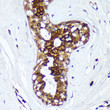| Tissue Specificity | Highly expressed in adrenal gland, liver, lung and thymus. Expressed in breast, ovaries, pituitary gland, pregnant uterus, prostate, kidney, lymph node, small intestine, spinal cord and trachea. Weakly expressed in all other tissues tested. Isoform 3: Expressed in eye ciliary epithelial cells and neuroendocrine cells. |
| Post Translational Modifications | Phosphorylated. |
| Function | Bifunctional enzyme involved in steroid-hormone metabolism and cholesterol biosynthesis. Catalyzes the NADP(H)-dependent reduction of estrogens and androgens and regulates the biological potency of these steroids. Converts estrone (E1) to a more potent estrogen, 17beta-estradiol (E2). Converts dihydrotestosterone (DHT) to its inactive form 5a-androstane-3b,17b-diol. Converts moderately progesterone to 3beta-hydroxypregn-4-ene-20-one, leading to its inactivation. Additionally, participates in the post-squalene cholesterol biosynthesis, as a 3-ketosteroid reductase. Isoform 3: Does not have enzymatic activities toward E1 and DHT. |
| Protein Name | 3-Keto-Steroid Reductase/17-Beta-Hydroxysteroid Dehydrogenase 717-Beta-Hydroxysteroid Dehydrogenase 717-Beta-Hsd 73-Keto-Steroid ReductaseDihydrotestosterone OxidoreductaseEstradiol 17-Beta-Dehydrogenase 7Short Chain Dehydrogenase/Reductase Family 37c Member 1 |
| Database Links | Reactome: R-HSA-191273 |
| Cellular Localisation | Endoplasmic Reticulum MembraneSingle-Pass Membrane Protein |
| Alternative Antibody Names | Anti-3-Keto-Steroid Reductase/17-Beta-Hydroxysteroid Dehydrogenase 7 antibodyAnti-17-Beta-Hydroxysteroid Dehydrogenase 7 antibodyAnti-17-Beta-Hsd 7 antibodyAnti-3-Keto-Steroid Reductase antibodyAnti-Dihydrotestosterone Oxidoreductase antibodyAnti-Estradiol 17-Beta-Dehydrogenase 7 antibodyAnti-Short Chain Dehydrogenase/Reductase Family 37c Member 1 antibodyAnti-HSD17B7 antibodyAnti-17HSD7 antibodyAnti-SDR37C1 antibodyAnti-UNQ2563 antibodyAnti-PRO6243 antibody |
Information sourced from Uniprot.org









